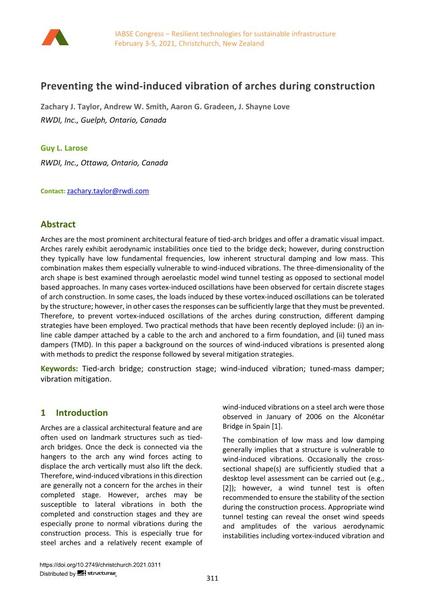Preventing the wind-induced vibration of arches during construction

|
|
|||||||||||
Bibliographic Details
| Author(s): |
Zachary J. Taylor
(RWDI, Inc., Guelph, Ontario, Canada)
Andrew W. Smith (RWDI, Inc., Guelph, Ontario, Canada) Aaron G. Gradeen (RWDI, Inc., Guelph, Ontario, Canada) J. Shayne Love (RWDI, Inc., Guelph, Ontario, Canada) Guy L. Larose (RWDI, Inc., Ottawa, Ontario, Canada) |
||||
|---|---|---|---|---|---|
| Medium: | conference paper | ||||
| Language(s): | English | ||||
| Conference: | IABSE Congress: Resilient technologies for sustainable infrastructure, Christchurch, New Zealand, 3-5 February 2021 | ||||
| Published in: | IABSE Congress Christchurch 2020 | ||||
|
|||||
| Page(s): | 311-318 | ||||
| Total no. of pages: | 8 | ||||
| DOI: | 10.2749/christchurch.2021.0311 | ||||
| Abstract: |
Arches are the most prominent architectural feature of tied-arch bridges and offer a dramatic visual impact. Arches rarely exhibit aerodynamic instabilities once tied to the bridge deck; however, during construction they typically have low fundamental frequencies, low inherent structural damping and low mass. This combination makes them especially vulnerable to wind-induced vibrations. The three-dimensionality of the arch shape is best examined through aeroelastic model wind tunnel testing as opposed to sectional model based approaches. In many cases vortex-induced oscillations have been observed for certain discrete stages of arch construction. In some cases, the loads induced by these vortex-induced oscillations can be tolerated by the structure; however, in other cases the responses can be sufficiently large that they must be prevented. Therefore, to prevent vortex-induced oscillations of the arches during construction, different damping strategies have been employed. Two practical methods that have been recently deployed include: (i) an in- line cable damper attached by a cable to the arch and anchored to a firm foundation, and (ii) tuned mass dampers (TMD). In this paper a background on the sources of wind-induced vibrations is presented along with methods to predict the response followed by several mitigation strategies. |
||||
| Keywords: |
tied-arch bridge construction stage wind-induced vibration vibration mitigation tuned-mass damper
|
||||
